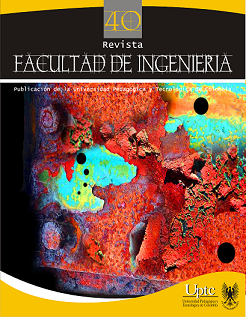Nitrate Ions’ Influence on the Alloy 22 Corrosion Behavior

Abstract
Alloy 22 (N06022), is a nickel based alloy, with a high content of chromium (∼22%) and molybdenum (∼13%) that belongs to the Ni-Cr-Mo alloys family. Different studies show that the alloy 22 is resistant to generalized and localized (in crevices) corrosion in aqueous solution, with high chloride concentration, and in a wide range of temperatures.
Electrochemical techniques such as Electrochemical Impedance Spectroscopy (EIS) and PotentiodynamicGalvanostatic-Potentiodynamic (PD-GS-PD) and non-electrochemical techniques such as the Scanning Electron Microscopy (SEM), were applied to determine the effect of the ionic nitrates and chlorides upon the alloy 22 at 90 oC generalized and localized corrosion.
The results show that for a critical molar concentration ratio R= [NO3 -]/ [Cl-] ≥0.2 it is completely eliminated the alloy 22 susceptibility to the crevice corrosion. The corrosion speed rates obtained were about 0.1μm/year at 24 hours of immersion.
Keywords
alloy 22, crevice corrosion, nitrates, repassivation potential, PD-GS-PD
References
- R. B. Rebak, “Metallurgical effects on the corrosion behavior of nickel alloys”, ASM Metals Handbook, Vol. 13A, Corrosion: Fundamental, Testing, and Protection, pp. 279-286, ASM International, 2003.
- Hastelloy C-22 Alloy, Haynes International, brochure H-2019F, 2002.
- N. S. Zadorozne, M. C. Goirdano, R. B. Rebak et al., “Anodic Behavior of Alloy 22 in Bicarbonate Media: Effect of Alloying”, Procedia Materials Science, Vol. 8, pp. 510-518, 2015.
- A. I. Asphahani, “Advances in the development of Ni-Cr-Mo-W alloy systems whit improved resistance to aqueous corrosion”, The Arabian Journal for Science and Engineering, pp. 317-335, 1989.
- H. M. Tawancy, R.B. Herchenroeder and A.I. Asphahani, “High-performance Ni-Cr-Mo-W alloys”, Journal of Metals, pp. 37-43, 1983.
- Geological Challenges in Radioactive Waste Isolation. Third Worldwide Review, Eds. P.A. Whiterspoon and G.S. Bodvarsson, University of California, Berkeley, CA, USA (2001).
- K. D. Crowley and J. F. Ahearne, “Managing the environmental legacy of U.S. nuclear-weapons production”, American Scientist, 90, 6, 514 (2002).
- Yucca Mountain Project, Eds. G. S. Bodvarsson, C.K. Ho, and B.A. Robinson, Elsevier (2003).
- Yucca Mountain Science and Engineering Report, U. S. Department of Energy, Office of Civilian Radioactive Waste Management, DOE/RW-0539, Las Vegas, NV, USA (2001).
- G. M. Gordon, “F.N Speller Award Lecture: Corrosion Considerations Related to Permanent Disposal of HigH-Level Radioactive waste”, Corrosion 58, 10, 811(2002).
- R. B. Rebak, Materials science and technology. A comprehensive treatment. Corrosion and environmental degradation, Vol. II pp. 69-111, Vol. Ed. M. Schuntze, Wiley, VCH, Weinheim, Germany (2000).
- R. B. Rebak, “Factors affecting the crevice corrosion susceptibility of Alloy 22”, Paper Nº 05610, Corrosion/05, NACE Intl., Houston, TX (2005).
- D. S. Dunn, Y.–M. Pan, K.T. Chiang, G.A. Cragnolino and X. He, “The localized corrosion resistance and mechanical properties of alloy 22 waste package outer containers”, Journal of Metals, p. 49, (2005).
- B. A. Kehler, G. O. Llevbare and J. R. Scully, “Crevice Corrosion Stabilization and Repassivation Behavior of Alloy 625 and Alloy 22”. Corrosion, 57, 12 (2001)1042.
- D. S. Dunn, L. Lang, C. Wu and G.A. Cragnolino, “Effect of inhibiting oxyanions on the localized corrosion susceptibility of waste package container materials”, SBNWM XXVII, MRS, Warrendale, PA, USA, Symposium Proceedings, Vol. 824, Paper CC1.7.1, 2004.
- G. O. Llevbare, “Effect of sulfate on the passive and crevice corrosion propierties of Alloy 22 in 4M sodium Chloride”. Corrosion, 62, 4, 340 (2006).
- D. S. Dunn, G. A. Cragnolino, Y.-M. Pan, and L. T. Yang, Effect of Fabrication Processes on Alloy 22, Paper No. 03697, Corrosion/2003, NACE International, Houston, Texas, 2003.
- R. M. Carranza, Environmental and Metallurgical Variables Affecting Crevice Corrosion Susceptibility of Alloy 22, Paper 08580, Corrosion/2008, NACE Int. Houston, TX, 2008.
- R. M. Carranza, Journal of Metals, p. 58 (January 2008).
- R. M. Carranza, M. Rincón Ortiz, M. A. Rodríguez, and R. B. Rebak, Corrosion resistance of Alloy 22 in chloride and silicate solutions, 14th International Conference on Environmental Degradation of Materials in Nuclear Power Systems-Water Reactors, August 23-27, ANS, Virginia Beach, VA (2009).
- R. B. Rebak, T.S.E. Summers, T. Lian, R.M. Carranza, J.R. Dillman, T. Corbin, and P. Crook, Effect of thermal aging on the corrosion behavior of wrought and welded alloy 22, paper 02542, Corrosion/02 (NACE International, 2002: Houston, TX), pp. 1-17.
- Annual Book of ASTM Standards, G78-95, p. 315 y G61-86, p. 239, 1996.
- A. K. Mishra and G. S. Frankel, “Crevice corrosion repassivation of alloy 22 in aggressive environments”, Corrosion Science, pp. 836-844, 2008.
- D. S. Dunn, Y. M. Pan, L. Yang, G. A. Cragnolino, Corrosion 61, 11, p. 1.076, 2005.
- ] R. M Carranza, M. A Rodríguez and R. B Rebak, “Effect of Fluoride Ions on Crevice Corrosion and Passive Behavior of Alloy 22 in Hot Chloride Solutions”, Corrosion 63, 5, p. 480-490, 2007.
- J. R. Galvele, “Transport processes and the mechanism of pitting of metals”, Journal of the Electrochemical Society, 123, 4, p. 464, 1976.
- Z. Szklarska-Smialowska, Pitting and crevice corrosion, NACE Int., Houston, TX, USA, 2005.
- P. Combrade, Crevice corrosion of metallic materials in corrosion mechanisms in theory and practice, second edition, ed. P. Marcus, Marcel Dekker, 2000.
- J. R. Galvele y G. S. Duffó, Degradación de Materiales –I. Corrosión, Buenos Aires: Jorge Baudino Ediciones, Instituto Sabato, UNSAMCNEA, 2006.
- M. Rincón Ortiz, M. A. Rodríguez, R. M Carranza, R. B Rebak. Crevice corrosion repassivation of alloy 22 in chloride solutions, NACE 2010, paper 10237.